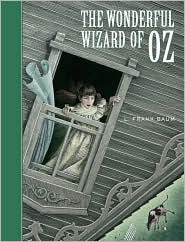The Evolution of Pop Culture Icons

Along the way, Hatcher sums up my general feeling about "dark Oz" adaptations after seeing one or two:what started as a one-off novelty is now its own genre, almost. Once a startlingly novel approach, it’s rapidly becoming a cliche. Even the good stuff can’t help but look a little tired just because it’s one more in a long line. How many times and how many ways can you do a clever adult re-imagining of the same juvenile property?
Especially if the cleverness consists mainly in imagining the popular details turned 180 degrees. It's easy to find the exact opposite of something, so such "dark" versions become predictable fast. Eventually, you come full circle. It reaches the point where a new juvenile version, told in modern idiom without any attempt to trade on nostalgia, is actually the novelty.
Hatcher then goes on to suggest that same pattern holds for a different sort of American mythos: the superhero universe. ...when you apply it [this pop-culture model] to Marvel and DC, you posit that things like the animated cartoons and DVDs are the new juvenile version, and the regular line of print comics that we see every Wednesday are the last gasp of the adult re-imagining of characters like Superman or Spider-Man.
One way to explore this idea further might be to go back earlier in popular culture than Oz, and see what happened to other fictional universes. For instance, Uncle Tom's Cabin started as a greatly affecting, hot political book, and soon became a staple of theater, then a music-house cliché and narrative for children. It inspired counter-narratives like The Klansmen and Gone with the Wind. Now it's read mainly by academics, and popular culture uses the title character's name as a pejorative.
Anyway. I can’t quite decide how I feel about it, if it’s good or bad or what.


5 comments:
Or how about the fairy tales of the Grimms? One of my favorite Cinderella knock-offs is by Ring Lardner. All guys and dolls. I've seen parodies and play-offs of those as far back as the time of their publication.
I should say, seems to me fairy tales are as much pop cultural icons as anything else.
Quite so, though it's hard to locate their origins and therefore see if the early parts of Hatcher's model apply. By this point, they're so old that we seem to see every manifestation at once: straightforward tellings for kids, parodies, sequels, adaptations, dark versions—not to mention scholarly examinations.
I guess I was particularly thinking about parodies and such closer to the time of the Grimms, in particular, since they were so popular. In fact, wasn't Baum referencing them in his intro to The Wizard of Oz?
Yes, Baum referred to Grimm and Andersen in his introduction to Wizard, discussed here. I consider that as much marketing copy, positioning his book for America on the verge of a new century, as an expression of Baum's working method.
If we date the Grimms' tales to when they were published and popularized, then there might indeed be parodies, dramatizations, and dark versions in the following decades following the basic timeline that Hatcher traced. I don't know that German literature well enough.
Post a Comment